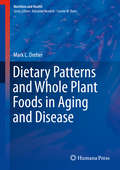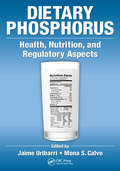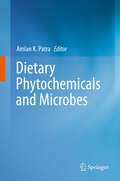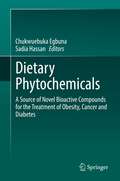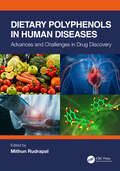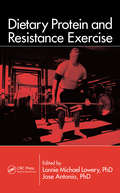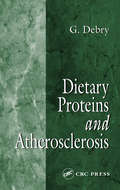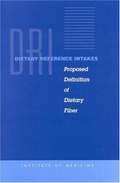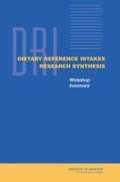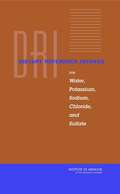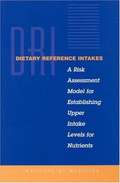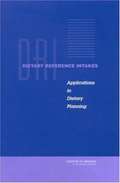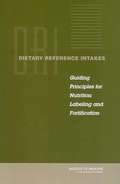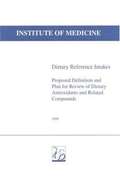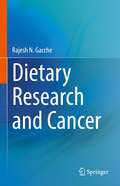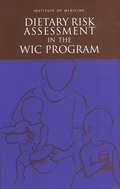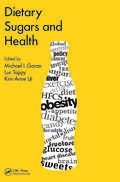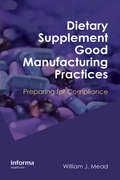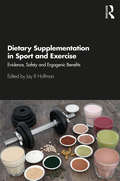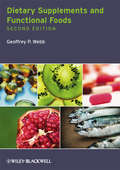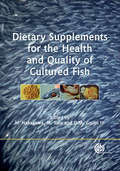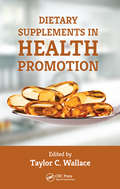- Table View
- List View
Dietary Patterns and Whole Plant Foods in Aging and Disease
by Mark L. DreherThis text provides a comprehensive review of the latest research on the effects of dietary patterns and whole plant foods on general health, aging, and cardiometabolic disease risk from major prospective cohort studies and randomized controlled trials (RCTs) and their meta-analyses. The book extensively assesses, the effects of lifestyle, dietary patterns, and specific whole plant foods on the quality of aging; the impact of fiber-rich foods on colonic microbiotia and weight regulation, the effects of which influence the quality of aging; the effects of fiber-rich diets on the aging gastrointestinal tract; and the role of dietary patterns and specific whole plant foods on coronary heart disease, hypertension, chronic kidney disease, stroke and type 2 diabetes. Figures are extensively used to highlight findings and tables summarizing food composition dietary patterns and whole plant foods. Tables summarizing meta-analyses and representative cohort studies and RCTs provide state-of-the-art coverage of the important effect of dietary patterns and whole plant foods on aging and cardiometabolic diseases.Dietary Patterns and Whole Plant Foods in Aging and Disease will serve as a very useful, state -of -the-art resource for dietitians, physicians, nurses, food industry scientists, researchers, naturopathic doctors, educators and their students interested in the role of dietary patterns and specific whole plant foods on aging and disease. The probability of healthy aging and disease prevention is significantly improved by 70% when individuals and populations follow a healthy lifestyle. Healthy lifestyle choices include adhering to a healthy dietary pattern, increasing physical activity most days of the week, achieving and maintaining lean body weight and waist size, and the cessation of smoking. It is estimated that 90% or more of those in westernized populations are on track for unhealthy aging and increased cardiometabolic disease risk, especially with the obesity pandemic associated with relatively poor diet quality and sedentary lifestyles. Healthy dietary patterns significantly lower risk of all-cause mortality and chronic disease incidence compared to Western dietary patterns. Since healthy whole and minimally processed plant foods vary widely in their nutrient and phytochemical compositions, their overall benefit in aging and disease may vary depending on the specific whole plant foods consumed.
Dietary Patterns, Food Chemistry and Human Health (SpringerBriefs in Molecular Science)
by Michele Barone Suresh D. SharmaThis brief discusses the influence of modern food production on dietary patterns and chronic diseases. In four concise chapters the authors explore different aspects of this topical issue. Chapter one highlights the importance of advanced glycation end products in food and describes how high levels of these complex molecules can lead to an increase in chronic diseases. Chapter two addresses the role of carbohydrates in inexpensive and tasty foods, while chapter three outlines how vegetable fats, notably palm oil, are used in selected industrial foods and explores their relation to hyper-palatability and other health issues. Lastly, the fourth chapter discusses the increasing demand for high-protein foods and the concomitant availability of vegan products. This brief is of interest to researchers in food production, food hygiene and public health, but is also relevant for certification bodies and specialists in the food industry.
Dietary Phosphorus: Health, Nutrition, and Regulatory Aspects
by Jaime Uribarri Mona S. CalvoPhosphorus is an essential nutrient that occurs in almost all foods and is important for many normal physiological functions. In a typical Western diet, it is not harmful, but does adversely affect tissues in the body when consumed in excess or deficiency. This book provides a comprehensive review of various aspects of phosphorus in relation to human nutritional needs. Sections cover phosphorus nutrition and dietary issues; health risks associated with excess phosphorus intake that exceeds requirements; phosphorus intake in populations at risk; regulatory challenges and policy approaches; and environmental impacts of phosphates in the modern food supply. This book challenges the long held ideas that high dietary phosphorus intake beyond nutritional requirements is safe and the natural supply of phosphorus critical to agricultural and human food production is endless. Controversy surrounds the claim that largely unrestricted use of phosphorus in all aspects of food production from farm to fork increases dietary phosphorus intake and irretrievable environmental loss, both of which harm human and environmental health. The book editors have joined together experts in basic, medical, environmental, nutritional, and food science to explore the validity of these claims of harm from high intakes and the unchecked use of phosphorus in the global food supply. Despite the essential need for adequate phosphorus over all stages of plant, animal and human life, the growing evidence points to a worldwide increase in dietary phosphorus intake far beyond nutrient requirements, significant association with chronic disease risk even when renal function is not compromised, and the increase in environmental loss with crop run-off, animal husbandry, and unretrieved phosphorus from human waste. This current evidence alludes to a depleted, unsustainable natural supply of phosphorus, hazardous environmental pollution of lakes and waterways, and significant increases in the risk of kidney, skeletal, and other serious illnesses in humans in the future if action is not taken now.
Dietary Phytochemicals and Microbes
by Amlan K. PatraHumans have utilized the bioactive principles of different plants for various beneficial physiological properties including antimicrobial properties for many centuries. However, interests of using medicinal plants declined in the 20th century with the availability of effective synthetic antimicrobial drugs. The development of microbial resistance to various drugs has accelerated research interests towards the use of phytochemicals as alternatives to synthetic drugs in the recent years. This book presents an comprehensive reviews on the antimicrobial and antiviral properties of numerous recently reported phytochemicals, and their mechanisms of antimicrobial actions. Some of the chapters have critically discussed the beneficial and adverse effects of antibacterial, and stimulatory activities of dietary phytochemicals on rumen microbial populations, and gut microbial populations of humans and animals. Microbial adaptation and resistance of microbes to phytochemicals has also been highlighted. On the applied apects, the use of phytochemicals against drug resistance microbes, to treat microbial diseases, for food preservation, to inhibit methanogenic archaea in the rumen, and to modulate lipid biohydrogenating microbial populations to increase conjugated linoleic acids in animal-derived foods have been presented in different chapters.
Dietary Phytochemicals: A Source of Novel Bioactive Compounds for the Treatment of Obesity, Cancer and Diabetes
by Chukwuebuka Egbuna Sadia HassanThis book presents comprehensive coverage on the importance of good nutrition in the treatment and management of obesity, cancer and diabetes. Naturally occurring bioactive compounds are ubiquitous in most dietary plants available to humans and provide opportunities for the management of diseases. The text provides information about the major causes of these diseases and their association with nutrition. The text also covers the role of dietary phytochemicals in drug development and their pathways. Later chapters emphasize novel bioactive compounds as anti-diabetic, anti-cancer and anti-obesity agents and describe their mechanisms to regulate cell metabolism. Written by global team of experts, Dietary Phytochemicals: A Source of Novel Bioactive Compounds for the Treatment of Obesity, Cancer and Diabetes describes the potentials of novel phytochemicals, their sources, and underlying mechanism of action. The chapters were drawn systematically and incorporated sequentially to facilitate proper understanding. This book is intended for nutritionists, physicians, medicinal chemists, drug developers in research and development, postgraduate students and scientists in area of nutrition and life sciences.
Dietary Polyphenols in Human Diseases: Advances and Challenges in Drug Discovery
by Mithun RudrapalDiets rich in plant polyphenols or dietary polyphenols are the subject of increasing scientific interest because of their diverse range of health benefits and medicinal uses. This book, Dietary Polyphenols in Human Diseases: Advances and Challenges in Drug Discovery, fills the gap that exists in the current knowledge by presenting the latest information in the area of polyphenol-based drug discovery research. The book focuses on the current understanding of the beneficial effects on human health of diets rich in polyphenols and/or polyphenolic compounds derived from dietary sources (plant-based foods) and their possible preventive role in the management of chronic human diseases. In addition, biochemical mechanisms involved in the antioxidative effect of dietary polyphenols along with their bioavailability, pharmacokinetic, and toxicological considerations are also discussed herein. Key Features Presents health benefits and medicinal importance of dietary polyphenols having antioxidative effects and their possible preventive role against oxidative stress (OS)-induced chronic human diseases. Summarizes the latest understanding of the biochemical mechanism(s) involved in the antioxidative action of dietary polyphenols along with their bioavailability, pharmacokinetic, and toxicological considerations. Highlights novel approaches of drug discovery from dietary polyphenols through computational screening of bioactive phytochemical components. With contributions by a global team of experts (academics, scientists, and researchers), this book is intended to be a useful resource for a wider audience, particularly those working in the area of drug discovery and development research, such as discovery scientists, pharmaceutical scientists (R&D), formulation scientists, medicinal chemists, pharmacologists, toxicologists, phytochemists, biochemists, clinicians, researchers, students, teachers, and many others.
Dietary Protein and Resistance Exercise
by Jose Antonio Lonnie Michael LoweryDietary supplement companies and the food industry spend millions to reach resistance trainers-often with exaggerated marketing messages-while health practitioners continue to counsel athletes that their interest in protein is misguided and even dangerous. There appears to be a disconnect between scientists and almost everyone else in sports nutrit
Dietary Proteins and Atherosclerosis
by G. DebryDietary Proteins and Atherosclerosis provides a thorough review of the role of proteins in the development of atherosclerosis. The author reviews early research connections between dietary fat and cardiovascular disease caused by the build-up of plaque in arteries and examines other factors that contribute to atherosclerosis, such as infection and
Dietary Reference Intakes Proposed Definition of Dietary Fiber
by Panel on the Definition of Dietary FiberDietary reference intakes (DRIs) are quantitative estimates of nutrient intakes to be used for planning and assessing diets for healthy people. This report reviews the bases for defining dietary fiber in the US, Canada, and other countries and discusses the role of dietary fiber in health. It proposes new definitions for fiber in the diet and provides the rationale for these definitions, reviews analytical methods for components of fiber, and discusses where new methods need to be developed to fully implement the proposed definitions. This work lacks a subject index. Annotation copyrighted by Book News Inc. , Portland, OR.
Dietary Reference Intakes Research Synthesis Workshop Summary
by Institute of Medicine of the National AcademiesThe National Academies Press (NAP)--publisher for the National Academies--publishes more than 200 books a year offering the most authoritative views, definitive information, and groundbreaking recommendations on a wide range of topics in science, engineering, and health. Our books are unique in that they are authored by the nation's leading experts in every scientific field.
Dietary Reference Intakes for Water, Potassium, Sodium, Chloride, and Sulfate
by Panel on Dietary Reference Intakes for Electrolytes WaterThe Dietary Reference Intakes (DRIs) are quantitative estimates of nutrient intakes to be used for planning and assessing diets for healthy people. This new report, the sixth in a series of reports presenting dietary reference values for the intakes of nutrients by Americans and Canadians, establishes nutrient recommendations on water, potassium, and salt for health maintenance and the reduction of chronic disease risk. Dietary Reference Intakes for Water, Potassium, Sodium, Chloride, and Sulfate discusses in detail the role of water, potassium, salt, chloride, and sulfate in human physiology and health. The major findings in this book include the establishment of Adequate Intakes for total water (drinking water, beverages, and food), potassium, sodium, and chloride and the establishment of Tolerable Upper Intake levels for sodium and chloride. The book makes research recommendations for information needed to advance the understanding of human requirements for water and electrolytes, as well as adverse effects associated with the intake of excessive amounts of water, sodium, chloride, potassium, and sulfate. This book will be an invaluable reference for nutritionists, nutrition researchers, and food manufacturers.
Dietary Reference Intakes for Calcium and Vitamin D: For Calcium, Phosphorus, Magnesium, Vitamin D, And Fluoride (Dietary Reference Intakes Ser.)
by Institute of MedicineCalcium and vitamin D are essential nutrients for the human body. Establishing the levels of these nutrients that are needed by the North American population is based on the understanding of the health outcomes that calcium and vitamin D affect. It is also important to establish how much of each nutrient may be "too much." Dietary Reference Intakes for Calcium and Vitamin D provides reference intake values for these two nutrients. The report updates the DRI values defined in Dietary Reference Intakes for Calcium, Phosphorous, Magnesium, Vitamin D, and Fluoride, the 1997 study from the Institute of Medicine. This 2011 book provides background information on the biological functions of each nutrient, reviews health outcomes that are associated with the intake of calcium and vitamin D, and specifies Estimated Average Requirements and Recommended Dietary Allowances for both. It also identifies Tolerable Upper Intake Levels, which are levels above wish the risk for harm may increase. The book includes an overview of current dietary intake in the U.S. and Canada, and discusses implications of the study. A final chapter provides research recommendations. The DRIs established in this book incorporate current scientific evidence about the roles of vitamin D and calcium in human health and will serve as a valuable guide for a range of stakeholders including dietitians and other health professionals, those who set national nutrition policy, researchers, the food industry, and private and public health organizations and partnerships.
Dietary Reference Intakes: A Risk Assessment Model for Establishing Upper Intake Levels for Nutrients
by Food Nutrition BoardInformation on Dietary Reference Intakes
Dietary Reference Intakes: Applications in Dietary Planning
by Subcommittee on Interpretation Uses of Dietary Reference IntakesThe Dietary Reference Intakes (DRIs) are quantitative estimates of nutrient intakes to be used for planning and assessing diets for apparently healthy people. This volume is the second of two reports in the DRI series aimed at providing specific guidance on the appropriate uses of the DRIs. The first report provided guidance on appropriate methods for using DRIs in dietary assessment. This volume builds on the statistical foundations of the assessment report to provide specific guidance on how to use the appropriate DRIs in planning diets for individuals and for groups. Dietary planning, whether for an individual or a group, involves developing a diet that is nutritionally adequate without being excessive. The planning goal for individuals is to achieve recommended and adequate nutrient intakes using food-based guides. For group planning, the report presents a new approach based on considering the entire distribution of usual nutrient intakes rather than focusing on the mean intake of the group. The report stresses that dietary planning using the DRIs is a cyclical activity that involves assessment, planning, implementation, and reassessment.
Dietary Reference Intakes: Guiding Principles for Nutrition Labeling and Fortification
by Committee on Use of Dietary Reference Intakes in Nutrition LabelingSince 1997, the Institute of Medicine has issued a series of nutrient reference values that are collectively termed Dietary Reference Intakes (DRIs). The DRIs offer quantitative estimates of nutrient intakes to be used for planning and assessing diets. Using the information from these reports, this newest volume in the DRI series focuses on how the DRIs, and the science for each nutrient in the DRI reports, can be used to develop current and appropriate reference values for nutrition labeling and food fortification. Focusing its analysis on the existing DRIs, the book examines the purpose of nutrition labeling, current labeling practices in the United States and Canada, food fortification practices and policies, and offers recommendations as a series of guiding principles to assist the regulatory agencies that oversee food labeling and fortification in the United States and Canada. The overarching goal of the information in this book is to provide updated nutrition labeling that consumers can use to compare products and make informed food choices. Diet-related chronic diseases are a leading cause of preventable deaths in the United States and Canada and helping customers make healthy food choices has never been more important.
Dietary Reference Intakes: Proposed Definition and Plan for Review of Dietary Antioxidants and Related Compounds
by Standing Committee on the Scientific Evaluation of Dietary Reference IntakesThe National Academies Press (NAP)--publisher for the National Academies--publishes more than 200 books a year offering the most authoritative views, definitive information, and groundbreaking recommendations on a wide range of topics in science, engineering, and health. Our books are unique in that they are authored by the nation's leading experts in every scientific field.
Dietary Research and Cancer
by Rajesh N. GaccheThis book reviews all important aspects of dietary research associated with cancer with the aim of shedding new light on these conditions through combined understanding of traditional and new paradigms. The book is divided into 17 chapters, the first portion reinterprets healthy diets for cancer based on up-to-date evidence from a network science perspective, examining the dietary patterns, outcome of diet related clinical trials, emerging framework of molecular mechanisms and interactions of dietary interventions and their applications in personalized diet, ground realities of benefits and regulatory frame work for functional foods, nutraceuticals and supplements in cancer prevention and upcoming future prospectus in diet-cancer research.. The later part of the book discusses recent advances in understanding of the elaborative discourse on cancer and fasting, covering, for example, calorie restriction and fasting mimicking diet. Finally, different Dietary research and approaches are considered in the context of novel intervention for cancer research. Dietary Research in Cancer will be of interest for all researchers, nutritionists, students and clinicians in the field.
Dietary Risk Assessment In The Wic Program
by Committee on Dietary Risk Assessment in the WIC ProgramDietary Risk Assessment in the WIC Program reviews methods used to determine dietary risk based on failure to meet Dietary Guidelines for applicants to the Special Supplemental Nutrition Program for Women, Infants, and Children (WIC). Applicants to the WIC program must be at nutritional risk to be eligible for program benefits. Although “dietary risk” is only one of five nutrition risk categories, it is the category most commonly reported among WIC applicants.This book documents that nearly all low-income women in the childbearing years and children 2 years and over are at risk because their diets fail to meet the recommended numbers of servings of the food guide pyramid. The committee recommends that all women and children (ages 2-4 years) who meet the eligibility requirements based on income, categorical and residency status also be presumed to meet the requirement of nutrition risk. By presuming that all who meet the categorical and income eligibility requirements are at dietary risk, WIC retains its potential for preventing and correcting nutrition-related problems while avoiding serious misclassification errors that could lead to denial of services for eligible individuals.
Dietary Sugars and Health
by Michael I. Goran Luc Tappy Kim-Anne LêSugar consumption is suspected to play an important role in the pathogenesis of diabetes, cardiovascular disorders, fatty liver disease, and some forms of cancers. Dietary sugars-fructose in particular-also have a potential role in obesity and metabolic diseases.Dietary Sugars and Health presents all aspects of dietary sugars as they relate to heal
Dietary Supplement Good Manufacturing Practices: Preparing for Compliance
by William J. MeadDietary Supplement GMP is a one-stop "how-to" road map to the final dietary supplement GMP regulations recently issued by the FDA covering the manufacture, packaging, and holding of dietary supplement products.The recent regulations, outlining broad goals, intentionally avoid specifics to allow for future technological advances-leaving implementati
Dietary Supplement Regulation in the United States
by Taylor C. Wallace Douglas Mackay Rend Al-Mondhiry Haiuyen Nguyen James C. GriffithsContrary to the common belief that dietary supplements are "unregulated" in the United States, nutrients and other dietary ingredient-containing products have been regulated in this country for a little over a century at least in some capacity, initially through the Pure Food and Drug Act (PFDA) of 1906 and culminating with the many anticipated regulations to be implemented following the recent enactment of the Food Safety Modernization Act of 2010 (FSMA). The goal of this brief is to review and discuss the current statutes and regulations surrounding the ingredients, manufacturing standards, safety, and labeling of dietary supplements for the purpose of protecting consumers.
Dietary Supplementation in Sport and Exercise: Evidence, Safety and Ergogenic Benefits
by Jay R HoffmanDietary Supplementation in Sport and Exercise removes the myths associated with many dietary supplements. It provides an evidence-based approach to the physiological mechanisms related to popular supplements and examines the ergogenic benefits in both competitive and recreational athletes. <P><P> This text covers a variety of supplements, including vitamins and minerals, carbohydrates, protein and amino acids, beta-alanine, creatine and guanidinoacetic acid, caffeine and probiotics, as well as emerging ergogenic aids. Information on dosage, ceiling effects and washout periods is discussed, along with safety and legality for different sporting organizations. The book also offers an insight into the efficacy of certain dietary supplements in unique populations, like children and the elderly. Dietary Supplementation in Sport and Exercise is an important resource for advanced undergraduate and graduate students on exercise science, health and nutrition courses, as well as strength coaches, athletic trainers, nutritionists and personal trainers, and medical professionals who consult with patients on dietary supplementation.
Dietary Supplements and Functional Foods
by Geoffrey P. WebbThe study of nutritional supplements has become increasingly important within research establishments and universities throughout the world, and as the market for these products continues to grow, so does the need for comprehensive scientifically sound information about the products, their properties and potential health benefits. This second edition of Dietary Supplements & Functional Foods has been fully revised and expanded. The book looks at the accepted uses of dietary supplements and also explores the wider picture, identifying common themes and principles or particular categories of supplements. Much new information across the whole spectrum of this fascinating and expanding field is included, with additional material covering changes in relevant legislation, examples of superfoods, up-to-date information and informed debate concerning vitamin D, folic acid, fish oils and antioxidants Several new sections have been added to this successful and well-received book. This book is now even more user-friendly and ideal for course use, and an invaluable reference for those working in the health sciences, and the supplements industry. Dietitians, nutritionists, food scientists and food technologists will all find much of great use and value within its covers. All universities and research establishments where these subjects are studied and taught should have copies of this excellent new edition on their shelves.
Dietary Supplements for the Health and Quality of Cultured Fish
by Heisuke Nakagawa Minoru Sato Delbert M. Gatlin IIIThis book addresses current information on the effects of micronutrients and other efficacious substances from plants, animals and bacteria, with regard to quality and health of cultured fish. Each chapter contains tables, figures and is packed with many new references to help expand your knowledge of various aspects of fish culture technology.
Dietary Supplements in Health Promotion
by Taylor C. WallaceThe supplement market continues to grow annually with more than half of the population using these products for reasons spanning from health maintenance to disease prevention and/or treatment. Dietary Supplements in Health Promotion presents clear and concise evidence on how dietary supplements may contribute to maintaining health status. The book
